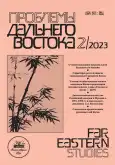Состояние и перспективы развития споров вокруг использования ресурсов реки Меконг
- Авторы: Бутко А.А.1
-
Учреждения:
- Институт востоковедения РАН
- Выпуск: № 2 (2023)
- Страницы: 93-104
- Раздел: Статьи
- URL: https://journals.rcsi.science/0131-2812/article/view/142492
- DOI: https://doi.org/10.31857/S013128120024926-9
- ID: 142492
Полный текст
Аннотация
Ключевые слова
Об авторах
Александр Александрович Бутко
Институт востоковедения РАН
Email: pdvjournal@mail.ru
107031, Москва, ул. Рождественка, д. 12
Список литературы
- Бокерия С.А., Нгуен Т. Hydropower development in Mekong River Basin // Азия и Африка сегодня. 2019. № 10. C. 24–29. doi: 10.31857/S032150750006522–6
- Демина О.В. Поворот на восток: риски и возможности увеличения экспорта российских энергоресурсов в Китай // Регионалистика. 2016. Т. 3. № 6. С. 47–55.
- Лихачева А.Б. Дефицит воды как фактор современных международных отношений: дис.… канд. пол. наук: 23.00.04. М.: Высшая школа экономики, 2015. 219 с.
- Томберг И.Р. Формирование энергетической политики КНР в начале XXI века: внутренние ресурсы и мирохозяйственные перспективы: дис.… док. экон. наук: 08.00.14. М.: ФАНО России, Институт востоковедения РАН, 2017. 305 с.
- Alexeeva O., Roche Y. The Chinese Perspective on the Issue of China’s Mekong Dams // L'Espace Politique. 2014. No. 24. URL: https://journals.openedition.org/espacepolitique/3268 (дата обращения: 23.11.2022).
- Basist A., Williams C. Monitoring the quantity of water flowing through the Upper Mekong Basin under natural (unimpeded) conditions. Bangkok, 2020. 21 p.
- Benxi Liu., Jay Lund., Lingjun Liu., Shengli Liao., Gang Li., Chuntian Cheng. Climate Change Impacts on Hydropower in Yunnan, China // Water. 2020. No. 1. URL: https://www.mdpi.com/2073–4441/12/1/197/htm (дата обращения: 23.11.2022).
- Brian Eyler. The United States and China in the Mekong: A Zero-Sum Game or a New Race to the Top? // Asia Policy. 2022. Vol. 17. No. 2. Pp. 7–13.
- Bunyeth Chan,Sébastien Brosse, Zeb S. Hogan, Peng Bun Ngor and Sovan Lek. Influence of Local Habitat and Climatic Factors on the Distribution of Fish Species in the Tonle Sap Lake // Water. 2020. No. 3. URL: https://www.mdpi.com/2073–4441/12/3/786/htm (дата обращения: 23.11.2022).
- Chua, S. D. X., Lu, X. X., Oeurng, C., Soc, T., Grundy-Warr, C. Drastic decline of flood pulse in the Cambodian floodplains (Mekong River and Tonle Sap system) // HESS. 2022. No. 26. URL: https://hess.copernicus.org/ articles/26/609/2022/ (дата обращения: 23.11.2022).
- Kamil Maitah,Luboš Smutka, Jeta Sahatqija, Mansoor Maitah, Nguyen Phuong Anh. Rice as a Determinant of Vietnamese Economic Sustainability // Water. 2020. No. 12. URL: https://www.mdpi.com/2071–1050/12/12/5123/htm (дата обращения: 23.11.2022).
- Marko Kallio, Matti Kummu. Comment on 'Changes of inundation area and water turbidity of Tonle Sap Lake: responses to climate changes or upstream dam construction?'// Environmental Research Letters. 2021. No. 5. URL: https://iopscience.iop.org/article/ 10.1088/1748–9326/abac79 (дата обращения: 23.11.2022).
- Mekong low flow and drought conditions in 2019–2021: Hydrological conditions in the Lower Mekong River Basin. Vientiane: Mekong River Commission Secretariat, January 2022. 81 p.
- Tian F., Liu H., Hou S., Li, K., Lu, H., Ni G., Mu, X., Baiyinbaoligao. Drought characteristics of the Lancang-Mekong basin and the role of reservoir regulation on streamflow. Centre for International Transboundary Water and Eco-Security, Tsinghua University, 2020. 30 p.
- Ye Wang, LianFeng, Jianguo Liu, Xuejiao Hou, Deliang Chen. Changes of inundation area and water turbidity of Tonle Sap Lake: responses to climate changes or upstream dam construction? // Environmental Research Letters. 2020. No. 9. URL: https://iopscience.iop.org/article/10.1088/1748–9326/abac79 (дата обращения: 23.11.2022).
- Zhang Li. Regionalization or Internationalization? Different Types of Water Multilateralism by China and the United States in the Mekong Subregion // Asia Policy. 2022. Vol. 17. No. 2. Pp. 14–20.










